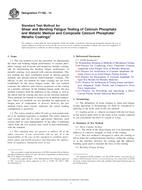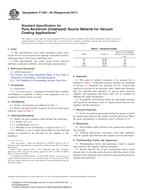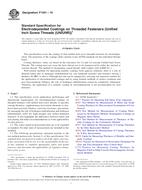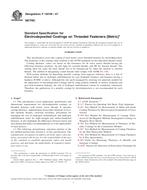Potrebujeme váš súhlas na využitie jednotlivých dát, aby sa vám okrem iného mohli ukazovať informácie týkajúce sa vašich záujmov. Súhlas udelíte kliknutím na tlačidlo „OK“.
ASTM B877-96(2013)
Standard Test Method for Gross Defects and Mechanical Damage in Metallic Coatings by the Phosphomolybdic Acid (PMA) Method
Automaticky preložený názov:
Štandardná skúšobná metóda pre hrubé chyby a mechanickému poškodeniu v kovových povlakov kyselinou fosfomolybdenovej (PMA) Metóda
NORMA vydaná dňa 1.12.2013
Informácie o norme:
Označenie normy: ASTM B877-96(2013)
Poznámka: NEPLATNÁ
Dátum vydania normy: 1.12.2013
Kód tovaru: NS-8580
Počet strán: 5
Približná hmotnosť: 15 g (0.03 libier)
Krajina: Americká technická norma
Kategória: Technické normy ASTM
Kategórie - podobné normy:
Anotácia textu normy ASTM B877-96(2013) :
Keywords:
electrodeposits, gross defects, mechanical damage, metallic coatings, porosity, testing for defects, wear through, ICS Number Code 25.220.40 (Metallic coatings)
Doplňujúce informácie
| Significance and Use | ||||||||||||||||||||||||
|
5.1 The primary purpose of the PMA test is to determine the presence of mechanical damage, wear through, and other gross defects in the coating. Most metallic coatings are intended to be protective, and the presence of gross defects indicates a serious reduction of such protection. 5.2 The protection afforded by well applied coatings may be diminished by improper handling following plating or as a result of wear or mechanical damage during testing or while in service. The PMA test can serve to indicate the existence of such damage. 5.3 This test is used to detect underplate and substrate metal exposed through normal wear during relative motions (mating of electrical contacts) or through mechanical damage. As such, it is a sensitive pass/fail test and, if properly performed, will rapidly detect wear through to base metals or scratches that enter the base metal layers. 5.4 This test is relatively insensitive to small pores. It is not designed to be a general porosity test and shall not be used as such. The detection of pores will depend upon their sizes and the length of time that the reagent remains a liquid. 5.5 This test cannot distinguish degrees of wear through or whether the wear through is to nickel or copper. Once base metal is exposed, the colored molybdenum complex is formed. While relatively small area defects (compared to the area of the droplet) may be seen at the bottom of the drop as tiny colored regions immediately after applying the PMA, any larger areas of exposed base metal will cause the entire droplet to turn dark instantly. 5.6 The PMA test also detects mechanical damage that exposes underplate and substrate metal. Such damage may occur in any postplating operation or even at the end of the plating operation. It can often occur in assembly operations where plated parts are assembled into larger units by mechanical equipment. 5.7 The PMA test identifies the locations of exposed base metal. The extent and location of these exposed areas may or may not be detrimental to performance. The PMA test is not recommended for predictions of product performance, nor is it intended to simulate field failure mechanisms. For such contact performance evaluations, an environmental test known to simulate actual failure mechanisms should be used. 5.8 The PMA test is primarily intended for the evaluation of individual samples rather than large sample lots, since evaluations are normally carried out one at a time under the microscope (see Section 10). 5.9 This test is destructive. Any parts exposed to the PMA test shall not be placed in service. |
||||||||||||||||||||||||
| 1. Scope | ||||||||||||||||||||||||
|
1.1 This test standard covers equipment and methods for using phosphomolybdic acid (PMA) to detect gross defects and mechanical damage including wear through in metallic coatings of gold, silver, or palladium. These metals comprise the topmost metallic layers over substrates of nickel, copper, or copper alloys. 1.2 Recent reviews of porosity testing, which include those for gross defects, and testing methods can be found in the literature.2, 1.3 The values stated in SI units are the preferred units. Those in parentheses are for information only. 1.4 This standard does not purport to address all of the safety concerns, if any, associated with its use. It is the responsibility of the user of this standard to establish appropriate safety and health practices and determine the applicability of regulatory limitations prior to use. |
||||||||||||||||||||||||
| 2. Referenced Documents | ||||||||||||||||||||||||
|
Podobné normy:
Historická
1.6.2014
Historická
1.6.2011
Historická
1.6.2011
Historická
1.12.2007
Historická
1.12.2007
Historická
1.6.2012



 ASTM F1160-14
ASTM F1160-14 ASTM F1367-98(2011)..
ASTM F1367-98(2011).. ASTM F1594-95(2011)..
ASTM F1594-95(2011).. ASTM F1941-10
ASTM F1941-10 ASTM F1941M-07
ASTM F1941M-07 ASTM F1978-12
ASTM F1978-12
 Cookies
Cookies
